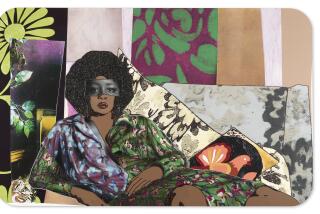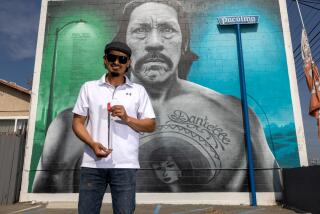All-woman art collective’s murals transform a drab corner of Pacoima
It’s early morning in Pacoima and hot already.
In the parking lot of the bustling USA Gasoline on Van Nuys Boulevard, an all-Latina crew of muralists lugs heavy cans of paint and ladders up to a blank, white cinder block wall.
People at the gas pumps stare. Others capture the scene on their smartphones. Passersby stop, curious — just ladies painting today?
This busy strip of Van Nuys Boulevard, lined with taquerias and laundromats, is now celebrated for its murals, including one of Mona Lisa in a sombrero with a rifle slung across her back and the colorful portrait of Pacoima-born singer Ritchie Valens.
But even here, on Mural Mile, where former graffiti artists point with pride to the elaborate murals they helped create, this all-female group turns heads. Most of the murals have been created by men.
The women call themselves the HOODsisters, a tough moniker meaning Honoring our Origins, Ourselves and our Dreams. They come from the working-class neighborhoods of the northeast San Fernando Valley, and their art is a blend of feminism and community pride.
On this spring morning the HOODsisters are painting a huge portrait of Toypurina, a Native American medicine woman who helped lead a revolt against the San Gabriel Mission in 1785.
Before they begin, a dozen HOODsisters stand in a circle near the blank wall to bless the work and to honor Toypurina, who is being painted with the San Gabriel Mountains and native California plants around her.
The women’s voices are soft, nearly drowned out by the passing traffic and the diesel truck engines idling at the gas pumps. They pass around a braid of sweetgrass, burnt at the end, and each woman gives thanks.
“Today, we’re honoring someone who was a warrior,” Karina Ceja says. “We’re honoring our origins.... We all come from different roots, but I think what’s important is that we hold onto that — that we are rooted like trees, that we are strong.”
::
Kristy Sandoval grew up in — and came back to — Pacoima.
She studied at the Academy of Art University in San Francisco, where she was captivated by the public art in the city, especially the colorful murals in the Mission District. It was so different than the emptiness of the walls back home, the blank beiges and grays, painted over and over again by store owners hurrying to cover graffiti.
When she came home, she was driven by a desire to bring some of that beauty to her own neighborhood and eager to find the young artists who might create it. She started teaching art workshops to at-risk youth and at schools.
“My intention was to get to the kids from the area out on the streets tagging and out getting in trouble,” said Sandoval, 31. “They want to paint, they want to create art. They have this tough exterior, but they just want attention; they want support with what they do.”
But there was something about the girls in her workshops that stuck with her, a certain sadness in their eyes.
“I would really see the problems with the young women in the area, like neglect from their parents or not having as much confidence as the men do,” said Sandoval, the mother of a 3-year-old daughter. “I’d see their lack of confidence in dreaming big and having goals to go to school.”
When Sandoval designed her first mural, she knew it should depict a woman. She approached Greg Faucett, the owner of Stylesville Barbershop & Beauty Salon on Van Nuys Boulevard about painting a mural on his northeast wall.
Faucett had one request: Make it a black person.
It was fate. Sandoval had long wanted to paint a mural of Assata Shakur — a former Black Panther who has been living in exile in Cuba since 1984.
Faucett says his is the oldest black-owned barbershop in the San Fernando Valley. It was opened by his grandfather in the late-1950s. Pacoima used to have a thriving black community, with black-owned businesses on both sides of Van Nuys Boulevard. Now, Stylesville is one of the few left in the area, which has become almost entirely Latino.
“I wanted the mural to show people there are still some blacks in the community,” Faucett said. “I think the community seeing a bunch of Latino girls painting a picture of a black lady on a black business, that’s very powerful right there.”
As they painted, people kept asking where the guys were, asking if they were a crew. They realized they had something special. The HOODsisters were born.
“We want to honor women,” Sandoval said. “My peers in the HOODsisters have all gone to college and come back. We hope it sends the message to women that you are intelligent and you can hold your own. I hope they’re empowered by what we’re doing.”
::
Sandoval stands away from the wall where Toypurina’s face is coming into form, a small smile on her face.
Sandoval is petite and quiet, her braided hair sticking out from under a baseball cap, her ripped jeans speckled with paint. The wall, she said, used to display soda and potato chips ads. On the rusting chain-link fence next to it, posters hawk sugary energy drinks.
“Our community doesn’t need that,” she says quietly. “We need something that’s more rich.”
By the wall, Stephanie Moreno, 31, laughs as she mixes blue and yellow paint to make green and, in the process, gets paint all over her hands.
“There goes my manicure!” she says.
A man walks over from the gas pumps, a little shy.
“Is it OK if I get a before and after picture?” asks George Godfrey, who lives nearby.
He’s surprised by the women, he says. He thought it was “only the guys” who painted the murals he’s grown to love. He wants to show the pictures to his teenage daughter.
::
One day, someone tagged the Toypurina mural.
Big, illegible white letters were spray-painted over a third of the 12-by-64-foot wall, obscuring the purple maps of California and tribal territory.
Saddened and angry, perhaps looking for someone to blame, the women gathered around a long wooden table in the Compañía de Café in San Fernando — five months after unveiling the mural — and toyed with the wording of a manifesto titled HOODsisters Denuncia that decried the tagging.
Before posting it on their Facebook page, they paused to make sure they were striking the right tone. They weighed whether to say they should have expected this in Pacoima — and quickly decided against it.
“A lot of love, sweat and effort went into this first mural,” the women finally wrote. “Two months later, we received the devastating news that our work had been tagged.... We all received this in different ways, heavy disappointment, sadness and anger.... We agreed that our ... emotions were valid; however, we decided to use compassion and resolution rather than blaming and shaming.”
The HOODsisters believe, they added, that graffiti is an art and that there should be more outlets available for creative young people.
That weekend, they gathered again at the gas station, the sun blazing, greeting each other with hugs and laughter. And they painted pink flowers where the graffiti had been.
Twitter: @haileybranson
More to Read
Sign up for Essential California
The most important California stories and recommendations in your inbox every morning.
You may occasionally receive promotional content from the Los Angeles Times.











